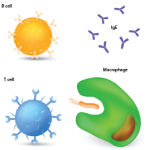Another underappreciated point is that the therapeutic effect of B cell–depletion therapy likely does not lie solely in the depletion of B cells. Not all of the effects of B cells promote autoimmunity. In particular, my colleagues and I have observed that the nature of B-cell reconstitution affects responses in SLE, with long-term responders demonstrating a prolonged expansion of immature transitional B cells after reconstitution (see Figure 2, above left).13 Of significant interest, expansion of transitional B cells also correlates with prevention of diabetes after B-cell depletion in nonobese diabetic mice.14 Thus, we postulate that the therapeutic benefit of B-cell depletion depends on the balance of pathogenic and protective B-cell functions. If this is true, long-term B-cell depletion may not be necessary or advisable, given that regulatory B cells are not distinguished from pathogenic B cells with current approaches.
Conclusions and Future Directions
Targeting B cells appears to be effective even in diseases where tissue damage is mediated by T cells, probably because B cells function as antigen-presenting cells as well as antibody-producing effector cells. B-cell depletion therapy can be remarkably efficacious in RA and remains a treatment strategy in refractory SLE. Recent controlled clinical trials of B cell targeting agents in SLE have had variable benefit but have contributed to our understanding of how to do trials in lupus and have recently shown promise. New agents capable of affecting long-lived plasma cells are now being developed. These agents should allow eradication of autoantibodies but will need to be used carefully to prevent infectious complication and to ensure that autoimmune plasma cells do not repopulate the long-lived plasma cell compartment. Important areas of future study include the identification of biomarkers, such as unique B-cell subsets and autoantibodies profiles, to better define responsive patient groups, determine the optimal timing of treatment and role of combination therapy, and the place of B-cell depletion in the therapeutic hierarchy.
Acknowledgments: Dr. Anolik has been supported by several grants including U19 Autoimmunity Center of Excellence AI56390, R01 AI077674-01A1, and the Lupus Research Institute. The contributions of collaborators, including Dr. Sanz and Dr. Looney, are especially noted.
Editor’s note: Dr. Anolik has served as a consultant for Genentech and Roche and has received grants for preclinical and translational studies from Proteolix and Amgen.
Dr. Anolik is associate professor of medicine in the division of allergy, immunology, and rheumatology of the department of medicine at the University of Rochester in New York.
References
- Shlomchik MJ, Madaio MP, Ni D, Trounstein M, Huszar D. The role of B cells in lpr/lpr-induced autoimmunity. J Exp Med. 1994;180: 1295-1306.
- Mamula MJ, Fatenejad S, Craft J. B cells process and present lupus autoantigens that initiate autoimmune T cell responses. J Immunol. 1994;152:1453-1461.
- Linton PJ, Harbertson J, Bradley LM. A critical role for B cells in the development of memory CD4 cells. J Immunol. 2000; 165:5558-5565.
- Chan OT, Hannum LG, Haberman AM, Madaio MP, Shlomchik MJ. A novel mouse with B cells but lacking serum antibody reveals an antibody-independent role for B cells in murine lupus. J Exp Med. 1999;189:1639-1648.
- Lorenz RG, Chaplin DD, McDonald KG, McDonough JS, Newberry RD. Isolated lymphoid follicle formation is inducible and dependent upon lymphotoxin-sufficient B lymphocytes, lymphotoxin beta receptor, and TNF receptor I function. J Immunol. 2003;170:5475-5482.
- Lu TY, Ng KP, Cambridge G, et al. A retrospective seven-year analysis of the use of B cell depletion therapy in systemic lupus erythematosus at University College London Hospital: the first fifty patients. Arthritis Rheum. 2009;61:482-487.
- Anolik JH, Ravikumar R, Barnard J, et al. Cutting edge: anti-tumor necrosis factor therapy in rheumatoid arthritis inhibits memory B lymphocytes via effects on lymphoid germinal centers and follicular dendritic cell networks. J Immunol. 2008; 180:688-692.
- Munafo A, Priestley A, Nestorov I, Visich J, Rogge M. Safety, pharmacokinetics and pharmacodynamics of atacicept in healthy volunteers. Eur J Clin Pharmacol. 2007;63:647-656.
- Salliot C, Dougados M, Gossec L. Risk of serious infections during rituximab, abatacept and anakinra treatments for rheumatoid arthritis: meta-analyses of randomised placebo-controlled trials. Ann Rheum Dis. 2009;68:25-32.
- Keystone E, Fleischmann R, Emery P, et al. Safety and efficacy of additional courses of rituximab in patients with active rheumatoid arthritis: an open-label extension analysis. Arthritis Rheum. 2007;56:3896-3908.
- Genovese MC, Breedveld FC, Emery P, et al. Safety of biologic therapies following rituximab treatment in rheumatoid arthritis patients. Ann Rheum Dis. 2009;68;1894-1897.
- Looney RJ, Srinivasan R, Calabrese LH. The effects of rituximab on immunocompetency in patients with autoimmune disease. Arthritis Rheum. 2008;58:5-14.
- Anolik JH, Barnard J, Owen T, et al. Delayed memory B cell recovery in peripheral blood and lymphoid tissue in systemic lupus erythematosus after B cell depletion therapy. Arthritis Rheum. 2007;56:3044-3056.
- Hu CY, Rodriguez-Pinto D, Du W, et al. Treatment with CD20-specific antibody prevents and reverses autoimmune diabetes in mice. J Clin Invest. 2007;117:3857-3867.

